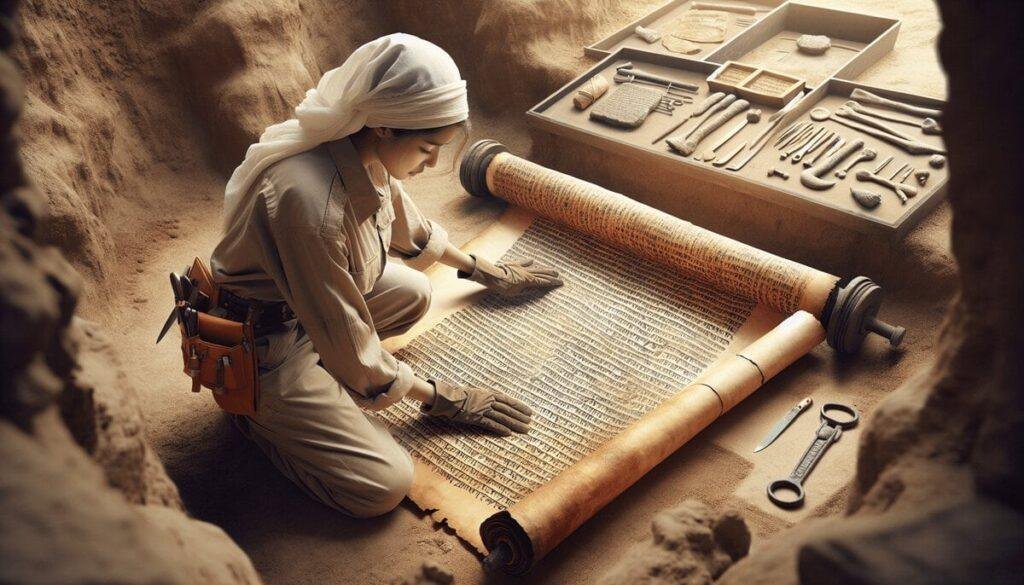In the fascinating field of Biblical Archaeology, researchers utilize various techniques to uncover and understand the ancient world described in the Bible. This article provides an overview of the different methods of excavation employed by experts as they meticulously dig through time. From stratigraphy to remote sensing, each technique offers valuable insights into the past and sheds light on the stories and civilizations that once thrived in the lands of the Bible. Get ready to embark on an excavation adventure and delve into the captivating world of Biblical Archaeology.

Introduction
Biblical Archaeological Excavation involves the careful study and excavation of artifacts and remains from ancient Biblical sites. This field of study provides valuable insights into the history, culture, and religious practices of peoples mentioned in the Bible. In order to carry out successful excavations, archaeologists employ a variety of techniques, each serving a specific purpose. This article aims to offer a comprehensive understanding of the various techniques used in Biblical Archaeological Excavation.
Stratigraphy
Definition
Stratigraphy is the study of rock layers and the formation of different strata. In Biblical Archaeological Excavation, stratigraphy is instrumental in understanding the chronological order of archaeological remains. It helps archaeologists determine how deep certain artifacts and structures are buried and the relationship between different layers. By carefully examining the different layers, archaeologists can reconstruct the history of the site and discern patterns of human activity.
Principles
The principles of stratigraphy guide archaeologists in determining the relative ages of artifacts and structures. These principles include the Law of Superposition, which states that younger layers of sediment are deposited on top of older layers. Other principles include the Law of Original Horizontality, which suggests that layers of sediment are initially deposited horizontally, and the Law of Lateral Continuity, which indicates that layers extend horizontally until interrupted by another solid object or phenomenon.
Excavation Process
To utilize stratigraphy effectively, archaeological excavations should follow a systematic process. Initially, the archaeological team establishes a grid system to divide the site into smaller sections. Each section is then excavated layer by layer, carefully recording and documenting any findings in situ. The excavated materials are analyzed, and stratigraphic relationships are established, allowing the team to create a comprehensive picture of the site’s history and the artifacts contained within it.
Surface Survey
Purpose
Surface surveys are conducted to gather information about a site without extensive excavation. They allow archaeologists to assess the distribution of artifacts across a broader area, aiding in the selection of potential excavation sites. Surface surveys are particularly useful when excavation is not feasible or when preliminary data is needed before committing to a full excavation.
Methods
Various methods can be employed during a surface survey, including pedestrian surveys, aerial photography, and geophysical techniques. Pedestrian surveys involve systematically walking across the surface of a site, visually inspecting and collecting any artifacts visible on the ground. Aerial photography employs drones or planes to capture high-resolution images of the site, revealing details not easily seen from ground level. Geophysical techniques use instruments to measure variations in the physical properties of the soil, which can indicate the presence of buried structures or artifacts.
Findings
Surface surveys can yield important information about the layout of a site, the urban development of ancient cities, and the presence of specific features or structures. By analyzing the distribution of artifacts found on the surface, archaeologists can gain insights into the settlement patterns and trade networks of ancient civilizations. Additionally, surface surveys provide valuable contextual information that helps guide subsequent excavation efforts.

Test Excavation
Definition
Test excavation involves digging small exploratory trenches to gain a preliminary understanding of the archaeological site. These initial excavations serve as a means of testing the hypotheses derived from surveys and surface findings. Test excavations help determine the nature and significance of the site before committing to full-scale excavations.
Purpose
The main purpose of test excavations is to evaluate the site’s potential for further excavation. By excavating small trenches, archaeologists can gather valuable data about the stratigraphy, artifact density, and preservation conditions within the site. This information guides decision-making regarding the intensity and extent of future excavations.
Procedure
During a test excavation, archaeologists strategically select areas to excavate, taking into consideration the site’s topography, previous findings, and research objectives. The trenches are carefully excavated in layers, with each layer being meticulously documented and analyzed. This helps establish a preliminary understanding of the site’s chronology, cultural deposits, and potential for further excavation.
Vertical Excavation
Definition
Vertical excavation involves digging downwards into an archaeological site to uncover its stratigraphic layers in a vertical sequence. This technique allows archaeologists to analyze the vertical relationships between different layers, aiding in the interpretation of the site’s history.
Principles
The principles of vertical excavation involve maintaining the integrity of the stratigraphic sequence and carefully documenting each layer and its associated artifacts. Archaeologists excavate in small increments, typically removing layers of sediment measuring only a few centimeters in thickness. Through this methodical approach, the team can accurately determine the relative ages of different layers, identify cultural changes, and establish a timeline for the site’s occupation.
Techniques
To conduct vertical excavation, archaeologists use a variety of tools, including trowels, brushes, and hand shovels. Careful precision is necessary to prevent damage to the delicate layers and artifacts. Additionally, archaeologists often employ sieving techniques to extract small artifacts or organic remains from the excavated soil, providing further insight into the site’s past.
Horizontal Excavation
Definition
Horizontal excavation, also known as open-area excavation, involves the systematic removal of layers of soil from a site in a broad horizontal direction. This technique helps archaeologists understand the spatial relationships between different features and artifacts, providing insight into the organization and layout of ancient settlements.
Principles
The principles of horizontal excavation involve maintaining the integrity of each layer while excavating larger areas. Rather than focusing on vertical relationships, horizontal excavation emphasizes the lateral distribution of artifacts and structures. By uncovering larger expanses of a site, archaeologists can identify distinct areas such as streets, houses, or public spaces, gaining a better understanding of the site’s overall organization.
Techniques
During horizontal excavation, mechanized tools such as shovels, pickaxes, and trowels are used to remove layers of soil methodically. The area is divided into grids or quadrants, allowing for precise documentation of each excavated unit. As with vertical excavation, sieving is often employed to recover smaller artifacts and ecofacts, ensuring thorough analysis and interpretation of the excavated material.
Sieving
Purpose
Sieving is a critical technique used in the excavation process to recover small artifacts, ecofacts, or remains that may be overlooked during excavation. It involves passing the excavated soil through a mesh screen to separate fine particles, revealing any hidden archaeological material.
Methods
To sieve the excavated soil, archaeologists typically use a set of nested screens with different mesh sizes. The soil is poured onto the top screen, and it is gently shaken or agitated to allow smaller particles to pass through, leaving behind artifacts and larger sediment. The material retained on each screen is carefully examined for any significant finds.
Importance
Sieving is essential because it enables archaeologists to recover tiny objects, such as beads, coins, or animal bones, that may hold valuable information about the site’s occupants or the activities that took place there. It allows for a more detailed analysis of the site’s material culture and contributes to a comprehensive understanding of its past.
Surveying
Importance
Surveying is a pivotal aspect of archaeological excavation as it provides crucial information about the site’s topography, boundaries, and orientation. It helps archaeologists accurately map and record the position and layout of artifacts, structures, and other features within the site.
Methods
Various surveying methods can be employed during an archaeological excavation, including total station surveying, GPS (Global Positioning System), and photogrammetry. Total station surveying utilizes electronic surveying instruments to measure angles and distances between different points on the site. GPS technology allows for precise positioning using satellite signals. Photogrammetry involves capturing and analyzing photographs of the site from different angles to create detailed and accurate 3D models.
Equipment
Surveying equipment used in Biblical Archaeological Excavation includes total stations, theodolites, leveling instruments, GPS receivers, and cameras. These tools enable archaeologists to accurately measure and document the site’s features, aiding in the interpretation of its layout and structure.
Documentation
Importance
Thorough documentation is essential throughout the archaeological excavation process. It ensures the preservation of accurate records and enables other researchers to validate and piece together the findings. Proper documentation allows for the creation of detailed reports and publications, contributing to the advancement of knowledge in the field.
Techniques
Archaeologists employ various techniques for documentation, including written descriptions, photography, sketches, and drawings. Each artifact, feature, and layer is carefully recorded, noting its location, dimensions, and associations. This information is used to create comprehensive excavation reports and to facilitate further analysis and interpretation.
Tools
The tools used for documentation include notebooks, measuring tapes, compasses, cameras, and drawing materials. These tools enable archaeologists to accurately record the details of each find, creating a comprehensive archive of information that can be accessed and analyzed by future researchers.
Conclusion
The various techniques employed in Biblical Archaeological Excavation play a crucial role in unraveling the mysteries of ancient civilizations. Stratigraphy helps establish the chronological order of artifacts and structures, while surface surveys provide broader context and aid in site selection. Test excavations offer preliminary insights, and vertical and horizontal excavations provide detailed information about the site’s stratigraphy and organization. The sieving technique ensures the recovery of small but significant artifacts, and surveying and documentation techniques ensure accurate mapping and records. By combining these techniques, archaeologists can piece together the puzzle of the past, shedding light on the rich history contained within Biblical archaeological sites.





